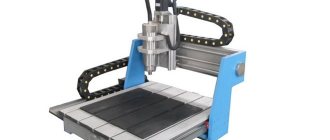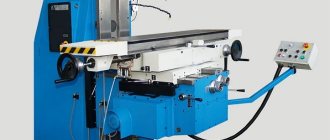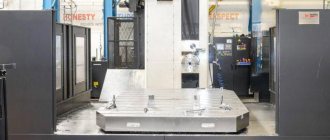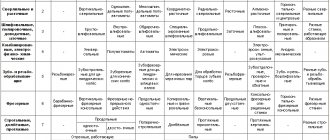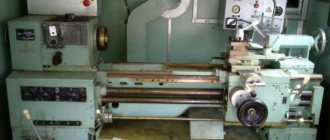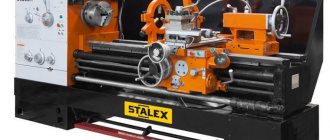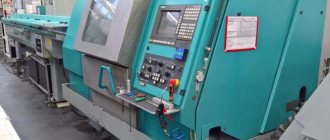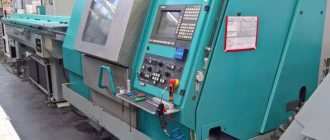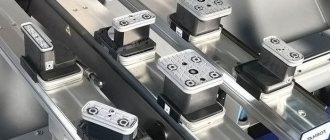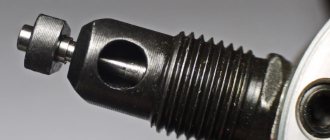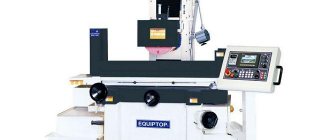Turning equipment is designed for processing workpieces from materials of various hardness - as a rule, they are used to produce parts that are bodies of revolution. Modern lathes are capable of processing external and internal surfaces that have a straight, conical or shaped shape.
The main cutting tools used to process parts are all kinds of cutters made of hard alloy metals, drills, lechers, taps, and countersinks. By and large, turning equipment is universal and can be used to perform various operations.
Specifications
When choosing a universal machine for working with metal workpieces, you need to take into account a number of parameters on which the capabilities of the equipment depend:
- Power - this parameter affects what types of metals can be processed.
- The dimensions of the machine - length, width, height - are selected depending on the availability of free space in the workshop.
- Working surface size - this parameter affects the permissible dimensions of the workpieces being processed.
- The length of the guides on which the caliper is mounted.
- Spindle type.
- Spindle rotation speed.
- Control Panel.
CNC equipment makes production more efficient. The operator sets an algorithm so that the moving mechanisms begin to independently perform the established operations. With software processing, the accuracy of the work performed increases.
Description
One of the most popular metalworking centers in the Russian Federation. It has a wide functionality, including performing different types of drilling, milling, and turning. Provides high-precision processing of products due to a special design:
- high-precision bearings;
- rigid main components provide resistance to vibration;
- overheat protection. Due to thermosymmetric elements);
- high quality CNC;
- high degree of control;
- spindle A8;
- chuck Ø 40 cm with hole 9.7 cm.
Designed for processing three-meter workpieces with a diameter of 40 cm. Allows you to reduce the cost of complex processing.
Reference. One turning and milling machining center can replace up to 5 CNC machines or up to 10 universal machines, but due to the high cost, the centers are not used for simple operations, but only for complex workpieces.
Device
Industrial devices are complex structures that consist of a number of elements interconnected by fasteners and wires. There are several parts in turning and milling machines:
- Bed - the base of the equipment on which other elements are fixed.
- A support is an element for securing the cutters. Modern models are equipped with mounts for installing several cutters. This allows you to perform a number of technological operations without additional operator intervention. The cost of the equipment depends on the number of working heads.
- The spindle is a moving mechanism.
- Tailstock.
Separately, it is necessary to say about the control system. CNC, which involves the installation of guides and stepper motors. They are responsible for the operation of moving mechanisms. Industrial equipment is complemented by a cooling system. It can be water or air. Metallurgists recommend choosing the second cooling option, since liquid can damage the structure of the device.
Functions
Turning and milling machines are multifunctional equipment that is designed to carry out various work operations:
- Production of parts with complex shapes.
- Thread cutting.
- Longitudinal, transverse turning.
- Milling of workpieces.
- Drilling holes.
- Boring holes.
- Surface grinding.
- Processing of ends, holes, complex bends.
Due to the capabilities of such equipment, it is used in various areas of industry.
Production of parts
Types of processing performed on lathes
As mentioned above, almost all lathes can be classified as universal. By installing various cutting tools on them and using all kinds of technological equipment, you can perform the following operations:
- Grooving of internal and external rotation surfaces with different configurations.
- Drilling , reaming, reaming and countersinking holes along the axis of rotation of the workpiece.
- Cutting threads using a cutter, tool or die.
- Processing the ends of the workpiece.
- Parts alignment.
- When using additional equipment, it is possible to perform a grinding .
And this is not a complete list of operations that can be performed using turning equipment. Modern machines of this type, equipped with software, are capable of producing a completely finished product in one or two installations - which is why they are classified as universal equipment called machining centers.
Operation and repair
To work more efficiently with turning and milling machines, you need to know the features of operating and repairing equipment:
- When working with a CNC system, you need to know how to set algorithms and correct errors in the computer.
- Before starting work, you should check the tension of the belts, the condition of the fastening elements, the sharpness of cutters and cutters.
- Make sure the wires are intact and connected to the network.
- Monitor the functionality of the mechanisms when operating the machine.
- Clean work surfaces from production waste. To do this, it is better to use a gun with a compressor.
- Lubricate moving mechanisms with engine oil.
- When working for a long time, use coolants. They protect equipment and workpieces from damage.
To avoid problems with machine repair, you need to make sure there is a warranty on the equipment. If bearings or fasteners fail, they must be replaced immediately with new ones.
Classification
The design of turning and milling equipment varies depending on various parameters. For example, there are manually adjusted machines and CNC mechanisms. Metallurgy masters classify these machines according to a number of other parameters.
Dimensions
Equipment is divided by size. The size determines which workpieces can be processed using the machine. There are these types of machines:
- Large ones - weighing more than 10 tons.
- Medium - weight 1–10 tons.
- Small - weight up to 1 ton.
There are industrial and desktop models. Tabletop machines include structures weighing up to 400 kg. With their help, workpieces 1200 mm long are processed. Such models are designed for working with metals and wood. Connect to a common 220V network.
Milling head type and drive
Turning and milling machines are classified according to the design of the milling spindle:
- models with counter spindle;
- simple mechanisms;
- with drive center;
- designs with a spindle equipped with a C-axis.
A separate drive drives the working tool. The efficiency of the equipment depends on the control system. Manual models are intended for one-time work. CNC machines are used in mass production.
CNC turning and milling equipment
By purpose and complexity
Equipment is divided according to purpose:
- for metal processing;
- for working with wooden workpieces.
To work with hard alloys, alloy or high-carbon steels, powerful equipment is used. The equipment must be made of durable materials.
Depending on the complexity of the equipment, two groups of machines are distinguished:
- Specialized - machines that are designed to perform certain operations. They don't reconfigure.
- Multifunctional - equipment that is installed in large enterprises. With its help, various technological operations are carried out.
CNC machines belong to the group of multifunctional ones. To configure and operate them, certain knowledge is required. The operator monitors the integrity of the equipment to prevent damage to equipment and workpieces.
Universal
Universal models differ from others by the presence of a C-spindle. The design of the working head has guides along which it moves in different directions. Universal installations allow the following technological operations:
- trimming parts;
- countersinking of holes;
- boring holes;
- drilling holes;
- grinding metal and wooden surfaces;
- thread cutting;
- selection of grooves;
- chiselling of recesses;
- processing of teeth.
Thanks to this, parts of complex shapes are produced. CNC models perform any operation with high precision. When machines operate, moving elements move using a given program. Modern models are equipped with sensors for maintaining specified dimensions, power consumption, and overheating.
Universal turning and milling machine
Processing
The European brand “TRENS” produces a line of machines with an inclined bed. Their unique design ensures high precision processing due to the special strength of the tools. The machines are aimed at large and medium-sized serial production and production of complex profiles and parts. The following models of TRENS machines are in demand:
- "SBL 500 A" is designed for parts weighing up to 1050 kilograms. The unit is equipped with a reliable drive (Fagor, Siemens), milling and boring is provided by a CNC system with a counter spindle. The headstock has a hydraulic drive and hydraulic fixation of the workpiece. Special operations are provided, such as off-axis drilling.
- The SBL 300 with a C-axis performs standard milling operations, including finishing of flanges, shafts and other complex parts, and is suitable for thread cutting. The particularly rigid spindle is designed for long-term high-speed rotation and high productivity of the machine. The C-axis has a disk locking system, which allows you to instantly switch operating modes.
- “SBL 700” is the most complex and technologically advanced, capable of processing heavy (up to 2500 kg) curved, stepped and straight profiles. Operation control is carried out from Siemens CNC with 3D programming (connection to a PC via the Internet is possible).
Recommendations for selection
When choosing a turning and milling machine model, you need to consider a number of features. In this regard, people involved in metalworking give the following recommendations:
- For mass production, it is better to use units with a CNC system. They allow the production of identical parts.
- If the equipment is used actively, cooling is needed.
- There are machines connected to a 220V network. They are used in private workshops.
The equipment is selected depending on the material being processed. Mills and cutters must be stronger than the metal used. When choosing a turning and milling machine, it is necessary to check the stability of the structure.
Operating principle of lathes
The operating principle of turning equipment is quite simple, despite the fact that the machines of this class themselves are quite complex units. Processing of the workpiece is carried out on them by combining two types of movement - rotation of the spindle, in the chuck of which the workpiece is installed, and longitudinal movement of the carriage with the cutter mounted on it. This tool moves along the axis of rotation of the workpiece, thereby cutting off a certain layer from it. Exactly the same principle is used to process the material using other tools.
How to make it yourself?
In order not to buy a turning and milling machine, you can make the unit yourself. The main element is the motor from the washing machine. Ready-made equipment allows us to produce piece parts from wood, metal, and alloys. Manufacturing stages:
- The structure of the homemade apparatus is made of metal parts. For this purpose, channels, corners, and rods are used. Metal parts are fastened using a welding machine.
- Next, the headstock and tailstock are made. In one of them the part is fixed, in the second the movable spindle with the working head is fixed.
- To process the side of the workpiece, a separate support is installed. Cutters or chisels are attached to it.
- Additionally, protective shields and lighting are installed.
Belts are used to transfer rotational energy from the engine to the cutter.
They should be tightened periodically. You can work with large parts only after installing a powerful engine. Before starting to process workpieces, check the sharpness of cutters, cutters, and chisels. Turning and milling machines are used in various areas of industry. They are used to make parts of complex shapes, make holes, and cut threads. CNC models allow you to make identical parts without human errors.
What is a CNC metal machining center?
A simple lathe is designed for boring workpieces made of metal, wood or other hard materials clamped in spindles, as well as for drilling holes in them, cutting threads, “countersinking”, etc. In such a mechanism, the workpiece rotates, and the shape of the product is given by a fixed in the support there is a cutter that moves along the workpiece.
In a milling machine, on the contrary, the workpiece makes translational movements, and the milling cutter (cutting part with blades) fixed in the spindles rotates. A unit of complex design, combining the functions of both machines and using both types of heads for processing workpieces - cutters and cutters, is called a “turning-milling processing center”. Such a complex machine performs several operations simultaneously; it can process parts with a milling cutter and simultaneously carry out their boring.
Mini, tabletop machines for home
Many industrial enterprises have in their arsenal automatic processing centers with computer numerical control (CNC). Mini versions are also available for home use. Although they have less power and a compact size, they work no worse than their industrial counterparts, ensuring the highest quality of products.
If the machines of old models required the participation of skilled workers at each stage of metalworking, then modern centers can do everything on their own. Changing tools and autonomous installation of workpieces without human assistance have become possible thanks to automation. Numerical control sets processing modes and manages all operations, using time efficiently. One such modern CNC machining center is capable of quickly completing a task that twenty years ago would have required the 2-shift work of an entire workshop of workers with machines of various types.
